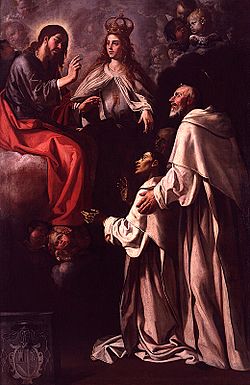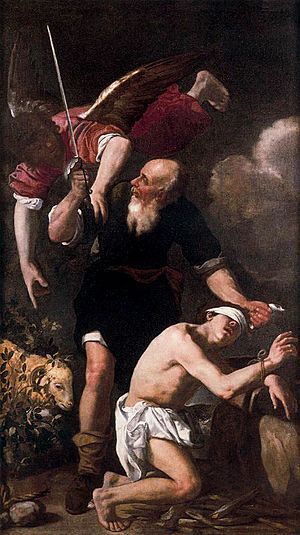Jerónimo Jacinto de Espinosa facts for kids
Quick facts for kids
Jerónimo Jacinto de Espinosa
|
|
|---|---|

Jerónimo Jacinto de Espinosa, Saint Peter Nolasco interceding, 1651-1652.
|
|
| Born | 18 July 1600 |
| Died | 20 February 1667 |
| Nationality | Spanish |
| Occupation | artist |
Jerónimo Jacinto de Espinosa (born 1600, died 1667) was an important Spanish painter. He was known for his amazing art during the Baroque period. This was a time when art was very dramatic and full of emotion.
Jerónimo's father, Jerónimo Rodriguez de Espinosa, was also a painter. His family moved to Cocentaina, where Jerónimo was born. He was the third of six children. In 1612, when Jerónimo was about 12 years old, his family moved back to Valencia.
Jerónimo's Life and Art
Jerónimo started learning to paint in his father's art studio. He was very talented from a young age. One of his early paintings was of John the Baptist. This painting showed how much he was influenced by another famous painter named Francesc Ribalta.
When he was 17, Jerónimo joined a new art school called the Colegio de Pintores. In 1622, he got married to Jerònima de Castro. She was the daughter of a local business person. The very next year, he started getting many requests for his paintings. Many of these were portraits of important people.
As he got older, Jerónimo was greatly inspired by the works of Pedro Orrente. This was especially true for his religious paintings. However, the influence of Ribalta could still be seen in his art.
Popular Subjects in His Art
Many of Jerónimo's most famous paintings showed the Virgin and Child. One example is "Our Lady of the Rosary." This painting is in the Basilica of Our Virgin of the Homeless. Another is "Virgin and Child on a Throne with Angels," which is now in the Museo del Prado.
He also often painted pictures of individual saints. What's cool is that all of his paintings are signed and dated. This makes it easy for art experts to see how his style changed over his career.
Toward the end of his life, Jerónimo received many painting jobs from the Order of the Blessed Virgin Mary of Mercy. In 1665, he worked on the main altar of a church in Massamagrell. Parts of this work can now be seen at the Museu de Belles Arts de València.
Jerónimo Jacinto de Espinosa was buried at the Convent of Santo Domingo. He left some paintings unfinished when he died. His son, also named Jerónimo, finished these works. Jerónimo Jacinto de Espinosa inspired many other artists, including Vicente Salvador Gómez and Mateo Gilarte.
Selected Works
Here are some of Jerónimo Jacinto de Espinosa's notable paintings:
- Retrato del padre Jerónimo Mos (Portrait of Father Jerónimo Mos), Museo de Bellas Artes de Valencia.
- Visión de San Ignacio (Vision of St. Ignatius) (1621), Museo de Bellas Artes de Valencia.
- Retrato de don Felipe Vives de Cañamás y Mompalau (1634), Kingston Lacy, Bankes collection.
- Muerte de San Luis Beltrán (Death of San Luis Beltrán) (1653), Museo de Bellas Artes de Valencia.
- Milagros de San Luis Beltrán (1655), Museo de Bellas Artes de Valencia.
- Última Cena (Last Supper) (1657), Santa María church, Morella.
- Virgen con el Niño (Virgin with the Child).
- Aparición de la Virgen al venerable Jerónimo Calmell (Apparition of the Virgin by the Venerable Jerónimo Calmell) (1660), private collection.
- Aparición de la Virgen a San Pedro Nolasco (Apparition of the Virgin at San Pedro Nolasco) (1661), Museo de Bellas Artes de Valencia.
- Aparición de San Pedro y San Pablo a Constantino (Apparition of Saints Peter and Paul at Constantine), Museo de Bellas Artes de Valencia.
- Golden Legend of Jacobus de Voragine.
- Milagroso hallazgo de la Virgen del Puig (1660), Museo de Bellas Artes de Valencia.
- Retrato del Padre Fray José Sanchís, Mercedario (Portrait of Padre Fray José Sanchís), (around 1659 and 1662), University of Valencia.
- Inmaculada (Immaculate) (1660), University of Valencia.
- La Inmaculada con los jurados de la ciudad (1662), Lonja de Valencia, The Golden Hall.
- Coronación de la Virgen (Coronation of the Virgin), Ayuntamiento de Valencia, Museo de la Ciudad (City Museum).
- Comunión de la Magdalena (1665), Museo de Bellas Artes de Valencia.
- Martirio de San Leodicio y Santa Gliseria (Martyr of Saints Leodicius and Glyceria) (1667), Colegio del Corpus Christi de Valencia.
See also
 In Spanish: Jerónimo Jacinto de Espinosa para niños
In Spanish: Jerónimo Jacinto de Espinosa para niños


